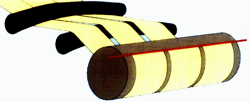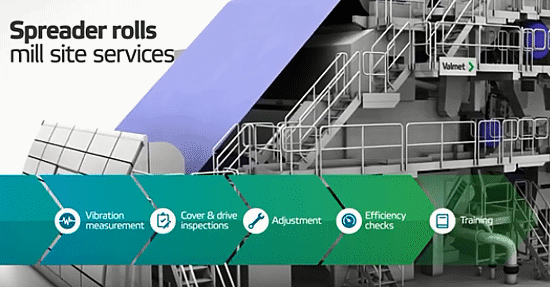Spreader rolls - principle, problems, solutions and services
Feb 11, 2020
If it were possible to design the perfect papermachine in which every component and moving part was aligned and set up with flawless precision to produce paper of perfect quality, spreaders would not exist. But, papermaking is anything but perfect.
The reality is web instability, caused by imperfections in alignment, web quality and traction, makes spreaders a necessary and invaluable component of the papermaking process.

But the spreader is not without troubles of its own. Due to operators who lack thorough working knowledge of its function and capability, spreader problems are commonplace. Often difficult for the operator to diagnose while the machine is running, improper tension can lead to interweaving and dishing, which usually results in a poor unusable end product.

Dual spreader on winder between slitter section and windup
Correction of spreader-related problems remains an inexact science. The minor adjustments operators make between sets or before grade changes are often done through trial and error. Different operating parameters such as sheet grade, roll widths and winder speed require different adjustments. The operator’s ability to make the proper adjustments at the proper time is the difference between a quality product or lost dollars. Success in this area begins by (1) gaining a greater understanding of the spreader’s two basic principles of operation (tension and traction) and the two most common problems associated with spreaders (interweaving and dishing), and (2) learning the possible steps to correct spreader problems.
Spreader principles
Tension
The very force that makes spreading possible is tension – the pressure that spreads the web in the cross-machine direction. Generally, high web tensions create a better spread than low web tensions. Too little tension reduces traction, which can result in a loss of web control. To regain the control the operator should increase tension, but carefully. If over-tightened, tension can cause overspreading, edge cracks and web breaks. A decrease in tension will reduce pressure on the web and create clean, straight edges for better winding.
Traction
Without traction on a rotating spreader, the spreading operation would not function. If traction is lost, so is tension, which reduces web control. An indication of a traction problem is poor spread at higher speeds while maintaining good spread at lower speeds.
Because the web moves differently at various speeds, it is important that traction remain constant in order to keep the web stationary in the spreader. Should traction drop and the web move, the roll will wind improperly with uneven edges.
To facilitate traction, most modern rotating spreaders are grooved to vent the air carried by the web.. In the case of rotating-type spreaders, traction can only be maintained when the spreader’s speed is equal to the sheet’s speed.
Spreader problems and solutions
Interweaving
The most common spreading problem occurs when webs overlap on interweave instead of winding separately onto individual rolls. Interweaving is difficult to detect in progress since the gap between webs being slit are often only fractions of an inch wide.
Run-togethers, as they are also sometimes called, can be caused by roll speed that is too fast or too slow; low web tension; loss of traction; cross machine sheet profile problems; or the incorrect spreader. Rather than correct the problem, mills will sometimes compromise and run fewer sets of rolls. While this may provide a quick fix to the problem, it is counterproductive. A better solution is to diagnose the spreading problem in order to meet the optimum number of sets off the winder.
Dishing
Ideally, a roll’s edge is perpendicular to the roll’s face. In the event dishing occurs, the roll’s edges become concave or convex (dish-shaped), with the web wrapping off the roll’s face. The end result is a roll that cannot be properly stacked, and requires rewinding or recycling. This is a problem common to newsprint grades.
Dishing generally stems from too little spreading of the web. Excessive spreading causes the outer layers of the sheet to shift away from the core, while too little spreading forces the edges of adjacent webs to rub together, producing dust or fuzzy edges. The dust produced by the friction can make pressroom work difficult, and even worse, damage other components in the machine.
Controlling tension and keeping a watchful eye on the spreader are the best methods for avoiding dishing and poor edge quality.
Spreader problems such as interweaving and dishing are common in finishing departments. However, operators can reduce the chance of these problems from ever occurring by increasing their knowledge of the spreader and making the proper adjustments in tension and traction.
Spreader roll services
Valmet spreader roll service increases roll lifetime, reduces overall mill maintenance costs and ensures wrinkle-free paper webs and fabrics while producing high quality paper. Spreader roll reconditioning will transform your spreader rolls to "as good as new" condition.

Spreader roll services also include upgrades to cost-effectively improve the technical characteristics of existing spreader rolls. Rolls can be upgraded in a number of ways, such as adding ceramic hybrid bearings, changing the coupling type between the shell spools or adding drying elements to extend bearing life.
For more information on Valmet spreader roll services, please visit this link. A video about Valmet spreader roll services may be found at this link.
For assistance in correcting and modernizing your spreading system performance, contact your Valmet representative.